The Unbreakable One enjoying some hefty floor press lockout work. Nice one.
Results matching “thumb”
Looking for some more finger-lifting fun? Here's Adam pulling 280lb. Love it.

Ask most people what they know about TS and they most likely picture Deuce Bigalow or another film that portrays Tourette's as that disease that makes people shout obscenities uncontrollably. But that's Hollywood TS. Even with cases as severe as mine, this symptom is incredibly rare, less than 1% of what are already considered "extreme" cases.
Some really quick background - TS is a neurological disorder that typically either makes people move involuntarily, or make noises involuntarily. Imagine the worst you've ever needed to sneeze - now pretend that feeling is always there, but it's not trying to make you sneeze, it's...well, it varies wildly and anything goes. My symptoms might remind you of the Tasmanian Devil, which I can live with - much more respectable than Deuce Bigalow. When things are at their worst, I yell, twitch, jerk my limbs around, scratch myself, punch myself, slobber, pant...and on and on and on. My brief fantasies of military service ended when I realized that nobody would want me hiding next to them. I couldn't ever even play hide and seek. One day four years ago I screamed so hard every 2-3 seconds that I got a hernia. I've also bitten through my lips and tongue more than once. A year ago I dislocated my thumb during a movie, just by wiggling it around too hard. Boo-hoo.
It sounds weird. It is weird. With all the amazing functions and limitless potential of the body and brain, there are just as many things that can get screwy along the way. And so I've struggled with this bizarre disorder for the last 10 years. It beat me down more than I'd like to admit. I was often unable to leave my house. I was too disruptive in public and too embarrassed. The years stretched out ahead of me in my mind, and I had little hope that I'd reach any of the goals I'd set for my life.
Then some small things changed. I want to be clear that nothing that follows is meant to be self-congratulatory. It's just the way that things happened. My father set me in motion and in retrospect, the rest seems inevitable.
I got into lifting. No particular reason, other than my dad did it and said it might give me some "small victories". A way to feel like I was in control. I was surprised by how quickly I came to enjoy my brief, modest workouts, and soon felt like something was wrong on days that I couldn't lift. My numbers were nothing special and still aren't, but it was the ritual of progress that mattered.
One thing led to another, and pretty soon I had discovered Dragon Door and the grip world. My house filled up with kettle bells. I began to spend lots of time worrying about how to strengthen my hands, of all things. And a funny thing happened...little by little, my passion for strength training took the place of the misery I'd let my disorder cause me. For ten years I had watched my body do whatever it wanted. And now, like an out-of-body experience, I saw myself putting that body through its paces during some wonderful, brutal workouts. I could suddenly look at myself and say: "You do whatever I tell you to, now shut up and get to it."
These primitive self-help sessions led to a discipline that has crept into everything I do, and much of what I am. By day I'm a humble librarian. My profession is not known for its physical might. If you ever do think of a library, chances are you picture a little old lady shushing the taxpayers in between her bun readjustments.
But in my office you'd see a bunch of kettle bells, some sledge hammers, a mess of chest expander bands, a pinch block from Strongergrip, a bunch of metal objects at various stages of being bent, and of course, stacks and stacks of books. The Diesel Crew bending manual also has a permanent spot on my PC's desktop.
When the chain breaks before your finger, you know it's a good day. 'Unbreakable' Adam Glass.
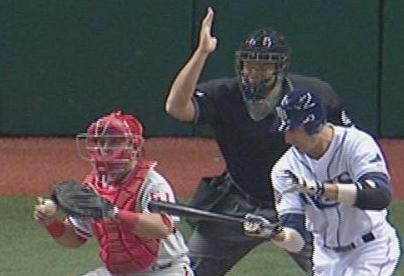
Wrist strength is also very important for keeping the wrist joint healthy. In contact sports, injuries of the wrist are all too common and they can be very nagging on the field or court. These injuries can take a very long time to heal, keeping the athlete out of the game for weeks at times. Strong wrists are more resilient against injury, so athletes must properly prepare them for competition forces.
Unfortunately, many sports teams are not strengthening their wrists properly. Often, sports teams' main grip, forearm, and wrist training is built around one single movement: Wrist Curls. While wrist curls are great for a pump, they do very little for the important sports-specific properties already established at the beginning of this article - force generation, bat/stick/racket control, and injury prevention.

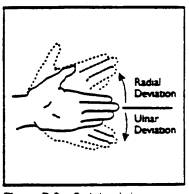
Proper wrist training should be done through all angles, encompassing the many different functions of the wrist including flexion, extension, and ulnar and radial deviation. The images at the left show these four basic movements of the wrist, and in order to prepare for competition, time in the weight room should be dedicated to strengthening all of them. It is plain to see that wrist curls are not going to cut in order to strengthen the wrist in the many angles of movement in which it is designed to perform. So the challenge is before us to find a suitable way to train the wrists.
The sledge hammer is a starting point. An 8-lb sledge hammer costs roughly $25, so it is not an expensive piece of equipment by any means, making it a painless addition to your training collection. The sledge hammer can be used to train the wrist in flexion, extension, and ulnar and radial deviation in a multitude of different ways. What follows is a series of simple exercises you can start off with, using the sledgehammer.
Vertical Lever to the Nose
The first exercise is the Vertical Lever to the Nose. The hammer is brought to the vertical position, lowered under control to the nose or head, and then returned to the vertical position. This exercise trains ulnar deviation.
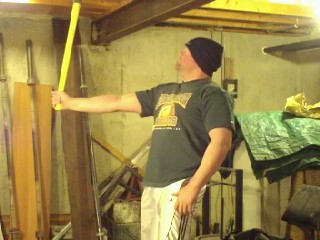
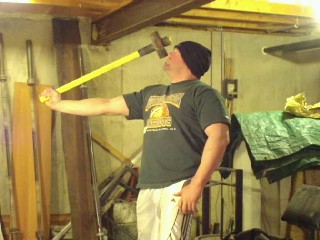
Possible variations:
- - Perform the exercise for reps at normal speed
- Perform the exercise for reps while moving the hammer slowly during the eccentric portion of the exercise
- Hold the hammer at the lowered position prior to returning the hammer to the upright position
- Adjust the grip up and down the handle to increase or decrease intensity, remove a finger or two to increase the crushing / dynamic support component of the fingers.
Adam continues to make card tearing look almost ludicrously easy. Here he is demolishing 1 3/4 decks, stacked. Good stuff.
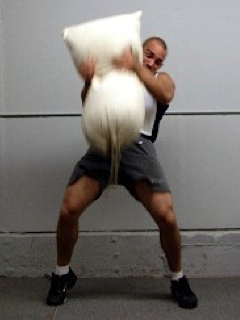
Enter the Thick Handled Hammer Curl
Hammer curls are a popular drill for many people working to add more size to their arms. I would like to present a simple variation that makes the hammer curl a great drill for grip strength and wrist power. By using a 2" to 2 and ½" handle, you will have to engage the grip and wrist for a superior total arm drill. This is very simple to use, and productive. I prefer to use the Strongergrip "Gripbell dumbbell" for this drill, the 3.5" ball makes the drill very challenging even with light weights. I personally prefer using heavier weights for lower reps to tax the thumb, but this drill can be used with a variety of programs from low rep to high rep. Do not allow the plates to touch the hand or wrist, allowing the weight to "lean" on the hand will reduce the leverage effect upon the arm. Maximize the disadvantage of the thick handle for new strength gains. You can make a fat handled bell by simply wrapping duct tape around the handle of a standard DB until you reach the desired thickness.
Enter the pistol squat
I am sure you have seen videos of it on the web. Maybe you know someone who can do one or two. Maybe this drill just plain freaks you out. The pistol squat is the real deal in athletic leg power, coordination and grace. The people who have spent a lot of time with this have built outstanding strength in the legs and hips. I think the best pistol squatter in the world is Steve Cotter, who is able to pistol two 32kg bells, and most impressively leap from the floor at bottom position to a table top with ease (video). The drill is difficult to learn, but in the process of learning it you will gain much skill in the areas of tension and body control. There are two resources for the pistol squat which are invaluable if you want this strength. Pavel offers the "Naked Warrior" Book and DVD and Steve's "Mastering the Pistol" DVD. I cannot think of one sport where mastery of the pistol would not help.

But what if you can not find any good hub plates at your gym? Are there other options for hub lifting that we can choose from, and still get the hand strength benefits? Yes there are!
IronMind.com sells an excellent hub lifting device called the Hub-Style Pinch Gripper. With a 2 and 7/8 inch gripping surface that is as slick as greased cow snot, this is one challenging grip training device. I have one of these implements and train on it from time to time. My best lift on it in pounds is only in the 50's. According to the IronMind page, with a lift in the 50's I'm "doing great," but if I hit 75 pounds, I should give them a call. I am in agreement. Big lifts on this device are earned, for sure. The standard way of lifting with the IronMind Hub, as I call it, is just simply attaching the V-shaped connection on the bottom of an implement to a carabiner, attached to a weighted loading pin or JumpStretch band. The IronMind Hub is a widely recognized standard for hub pinching implements, but other companies also sell them, including John Beatty at FatBastardBarbellCo.com.
Many grip strength enthusiasts also enjoy building their own grip strength implements from scratch. Recently, my good friend, Brad Martin, whom you have seen in many great video clips on the DieselCrew.com site, took the time to devise his own hub lifting implement. The list of items you'll need to make your own set-up is very short:
- 1 hockey puck
- 1 eye bolt
- 1 carabiner clip
- About 2 feet of chain (if you have no loading pin)
Adam Glass enjoying a little mitt action.
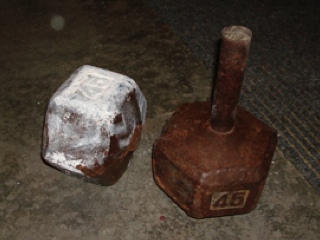
Since you may not want to cut up your good dumbbells, you can go to a garage sale and pick up someone's old rusted or banged up weights. To make a block weight, simply use a hacksaw to cut off the end of your chosen dumbbell. Make sure to place the hacksaw blade as close to the head of the weight as you can. Ensuring the proper blade placement will prevent excess grinding of any possible raw ends. Be patient because it will take you awhile to get through the handle. At least this will give you a good workout!
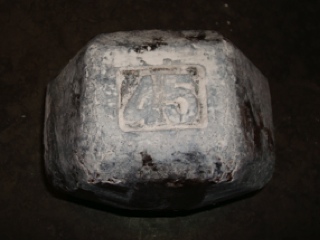
When training with the block weight, you will be using one hand at a time. Your thumb will be the main support while lifting the weight. Your index and middle finger will be the opposing force. Even though your ring finger and pinky can wrap around the weight, they will provide little force for the pinch on this type of weight. Still you will need to use them while you lift the weight. To help prevent slippage, put some chalk on the sides and top of the weight. Remember to chalk your hands up good too. Bend down and pinch the weight, putting the weight deep into the crook of your thumb and index finger. Wrap the rest of your fingers on the other side of the weight and pinch down hard. Stand erect with the weight once you are upright set the weight back down.
